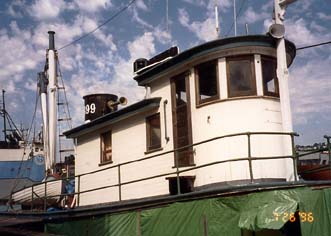|
Aids to
Preservation are not an End to Preservation
Painting and deck
preservation aboard tugboats is has been a never ending process and is
evolving as the coatings technology changes. Labor saving metal
treatments and paints that are being developed are supposed to save the
deckhand a little time and make his paint job last longer. Managers may
be using these products as short cuts rather than time savers and in the
end, the rust still comes through the new paint as fast as it ever did
before- maybe faster. Manufacturers created these products to make the
labor more efficient. They didn't intend to end all the work of the
crew.
At first, the deckhand
used the standard procedure for steel preparation and painting. That was
to chip the rust off down to hard steel, then wire brush the loose surface
rust and loose paint off. When the surface was smooth and shiny, two
coats of primer and two coats of topcoat were applied. Sometimes a coat
of phosphoric acid was applied to the open steel before any coatings were
applied. That would treat the rust and convert it to an inert substance.
This process took a little time but if all of the steps were completed
properly, this paint job would last about a year. Mangers complained
about the time, and rushed crews to finish often moving too fast to do a
good job.
Then, there came along
steel treatments that contained the conversion acids suspended in a
water-soluble base. The deckhand would chip the steel of any loose rust.
The loose and chipping paint would have to be knocked off but any tight
rust or paint could be left on the steel. A good coat of the steel
treatment was applied and the acids converted the rust to an inert
ingredient while the water-soluble base dried to a clear protective
coating. This saved a deckhand quite a bit of time because now he didn’t
have to spend as much time running the electric wire wheel over the job as
in the past. Managers are using this to treat and cover huge amounts of
rust and the product can’t convert all of it efficiently. The job turns
into nothing more than just painting over disguised rust.
Now there
are epoxy coatings that claim to completely seal in the rust. The
deckhand now only has to brush off the loosest rust and apply the sealer.
The sealer is so dense that it will prevent the oxidation process from
continuing, Topcoats can be applied to this sealer without the need to
prime and the rust will lie dormant under the shiny new paint until the
seal is broken. This method is saving time because now the deckhand only
has to scrape the rusty area with a minimum of power tool use. With only
two or three coat of paint over so much rust, the job doesn’t last as long
as it should.
The fundamentals of deck preservation
will always remain the same: 1. Remove the rust and failing paint. 2.
Clean and prime the bare metal. 3. Apply liberal coats of finish paint.
If these new products save time and labor on one phase of this process,
more time and labor should be used in another phase to get an extra step
ahead of the corrosion. To think that the crew can now completely skip a
crucial step in surface preparation without compensating for that step
elsewhere is just taking quality time away from a well-done paint job, no
matter what product is used.
|
|
|

